Rebuses with squares
In the following rebuses every square represents a digit. None of the numbers in these rebuses equals zero or begins with zero but any of them may end in a zero. Numbers under the line are sums of the numbers in the columns.
The sum of the numbers in the first column is the same as the result of the mathematical operations in the first row; the sum of numbers in the second column equals the result of the second row, etc.
The mathematical operations should always be performed in order from left to right. Also, at no time after completing a step of one of the horizontal equations will your subtotal be a fraction or a negative number.
Example
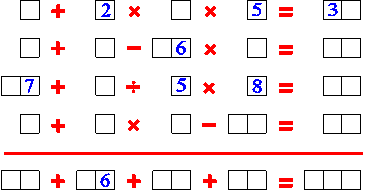
Our job is to fill the correct digits in the empty squares. Since the solution to the first row is equal to the sum of the first column (and similarly for the second row and second column), we can add numbers so the puzzle looks like this:
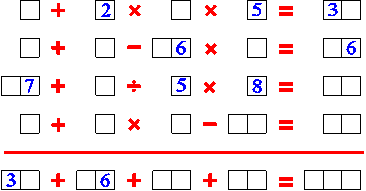
Let us look at the second row of the rebus. The sum of the first and the second numbers in the row cannot be more than 18, because neither can be greater than nine. The third number in the row must be 16 (if it were 26 or greater, subtracting it from the sum of the first two numbers would result in a negative number). The sum of the first two numbers must be greater than 16, so it is either 17 or 18.
If the sum were 17, 17 minus 16 equals 1, and you can’t multiply a single-digit number by one and end up with a two-digit number. Hence, the sum is 18, the first number must be 8, and the fifth (identical to the last number in the second column) is 16.
The rebus now looks like this:
If the sum were 17, 17 minus 16 equals 1, and you can’t multiply a single-digit number by one and end up with a two-digit number. Hence, the sum is 18, the first number must be 8, and the fifth (identical to the last number in the second column) is 16.
The rebus now looks like this:
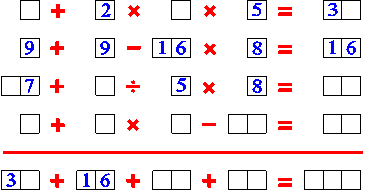
Let us now examine the second column of the rebus. The sum of the third and the fourth numbers in this column is 5 (16 – 2 – 9 = 5). Hence, each of these two numbers is less than 5.
In the third row, the first two numbers must add up to a number that is divisible by 5, so the third number in the second column is 3 or 8. But the number must be less than 5, so it’s 3, and the fourth number in the second column is 2.
The fifth number in the first row begins with 3 and can be divided by 5. This, the number is either 30 or 35. The sum of the first column will likewise be 30 or 35.
The third number in the first column can be 17, 27, 37 … etc.
Suppose it equals 27. Them the sum in the column exceeds 36 (9 + 27). But the sum must be either 30 or 35. Therefore, the third number in the first column is 17, and now the rebus looks like this:
In the third row, the first two numbers must add up to a number that is divisible by 5, so the third number in the second column is 3 or 8. But the number must be less than 5, so it’s 3, and the fourth number in the second column is 2.
The fifth number in the first row begins with 3 and can be divided by 5. This, the number is either 30 or 35. The sum of the first column will likewise be 30 or 35.
The third number in the first column can be 17, 27, 37 … etc.
Suppose it equals 27. Them the sum in the column exceeds 36 (9 + 27). But the sum must be either 30 or 35. Therefore, the third number in the first column is 17, and now the rebus looks like this:
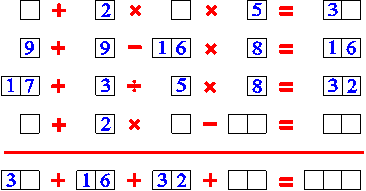
Let’s assume the last number in the first row is 35. Since the only two factors of 35 are 7 and 5, the sum of the first and second numbers in this row would have to equal 7, and the third number would be 1. So the first number in the third column would be 1, and we already know that the second number is 16 and the third number is 5. The fourth number would then have to equal 10 (32 – 1 – 16 – 5 = 10). But the fourth number must be a single digit. Therefore, the last number in the first row cannot be 35. Hence, it is 30.
We’ve already shown that the third number in the first row cannot be 1, and it can’t be 3 either, since then the first number in the row would have to be a zero, so the first row must be:
1 + 2 x 2 x 5 = 30
After this it is easy to reconstruct the fourth row:
3 + 2 x 9 – 12 = 33
And the final result is:
We’ve already shown that the third number in the first row cannot be 1, and it can’t be 3 either, since then the first number in the row would have to be a zero, so the first row must be:
And the final result is:
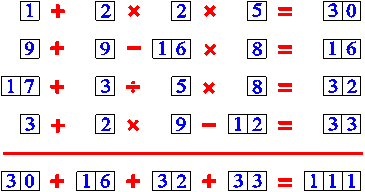
Try to solve the following rebuses: